
 Home Home |
 For authors For authors |
 Submission status Submission status |
 Current Current
|
 Archive Archive
|
 Archive
(English) Archive
(English)
|
 Search Search |
Transition metal dichalcogenide monolayers have recently drawn an attention of researchers due to their unusual properties and potential for applications in nanoelectronics. These are an atomically thin materials with general formula MX_2, where M is a transition metal atom like Molybdenum or Niobium etc., and X is a chalcogen atom like Sulfur of Selenium. It's crystalline structure lacks inversion symmetry which opens the possibility for intrinsic spin-orbit coupling. Due to this fact these systems have complicated band structure with few spin-splitted Fermi contours like depicted on figure.
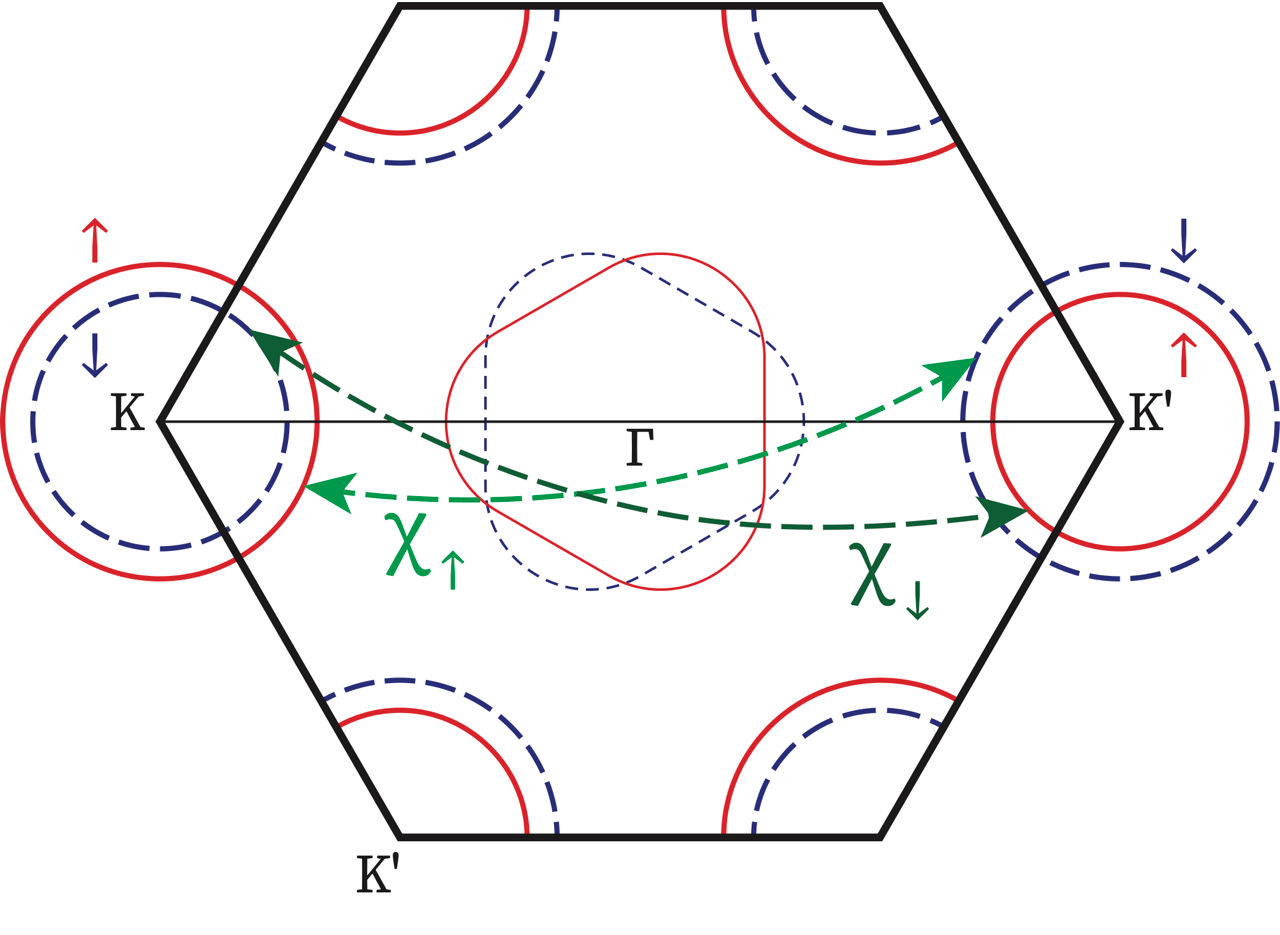
A.G.Semenov
JETP Letters 119, issue 1 (2024)
This work proposes a method for constructing a relative atomic gravimeter based on the use of an atomic fountain on ultracold atoms. The method is based on measuring the shift of the Ramsey spectrum line in an atomic fountain in a gravitational field. For a fountain-type microwave frequency standard on Cs atoms, the accuracy of the gravitational field measurement is $\delta g=2\times10^{-6}g/\sqrt{\tau_a}$. With integration time $\tau_a=10000 s$, the achievable accuracy is $\delta g\approx2\times10^{-8}\approx20\,\mu$Gal.
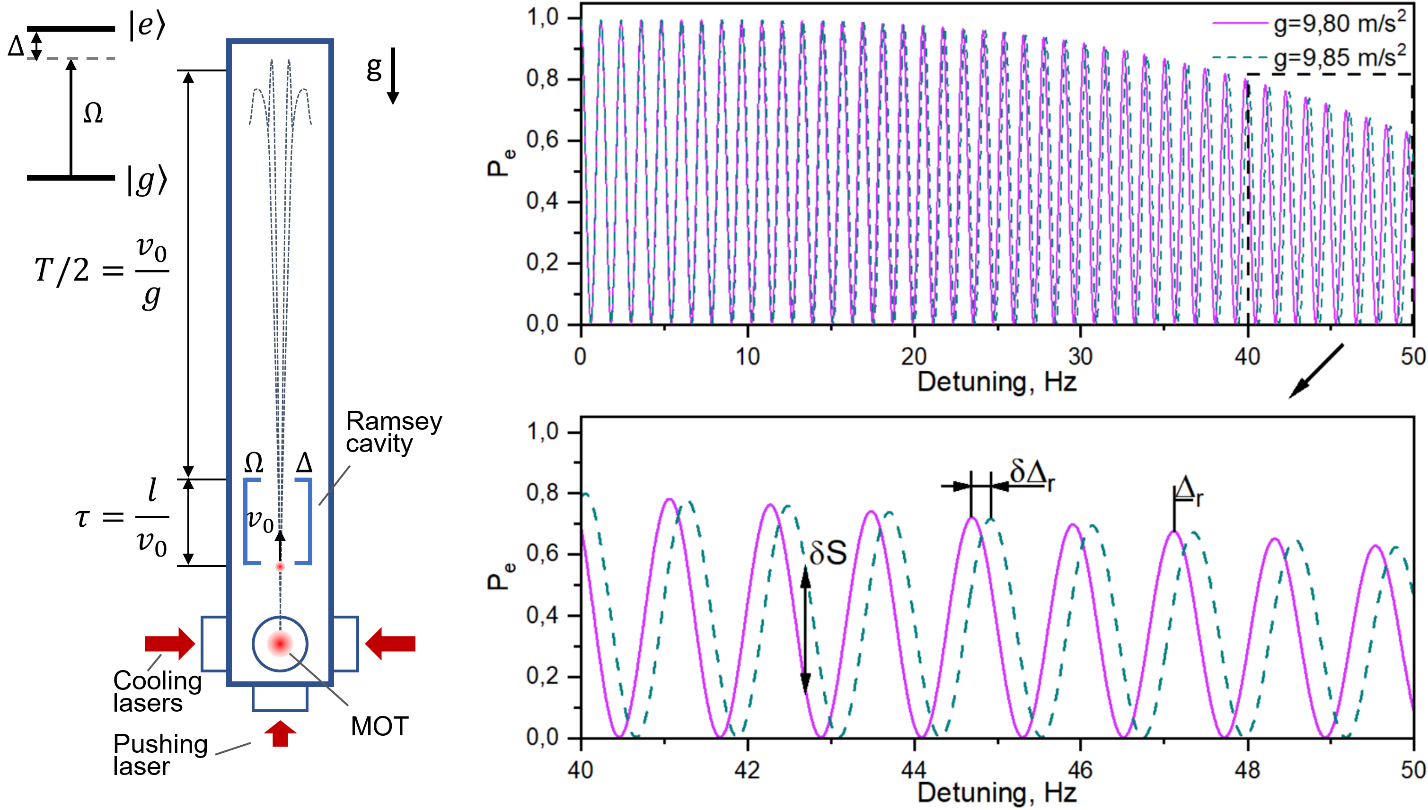
Schematic of an atomic fountain gravimeter using a microwave clock transition. The time of flight of atoms through a microwave gravimeter T depends on the acceleration of gravity g. This leads to a shift in the frequency corresponding to Ramsey resonances at frequencies other than the exact resonance when the acceleration of gravity changes.
A.Afanasiev et al.,
JETP Letters 119, issue 2 (2024)
For a magneto-optical trap (MOT) formed near an atom chip using 87Rb atoms we have investigated various loading modes: loading from thermal atomic vapors and from a low-velocity atomic beam. The possibility of controlling MOT loading by spatial control of the atomic beam was demonstrated using an atomic beam,. This enables to increase the speed of loading atoms into MOT while maintaining an ultra-high vacuum in the area of the atomic chip. Under optimal loading conditions, the maximum number of atoms in MOT was 4.9 × 107, whereas the lifetime of atoms in MOT was 4.1 s.
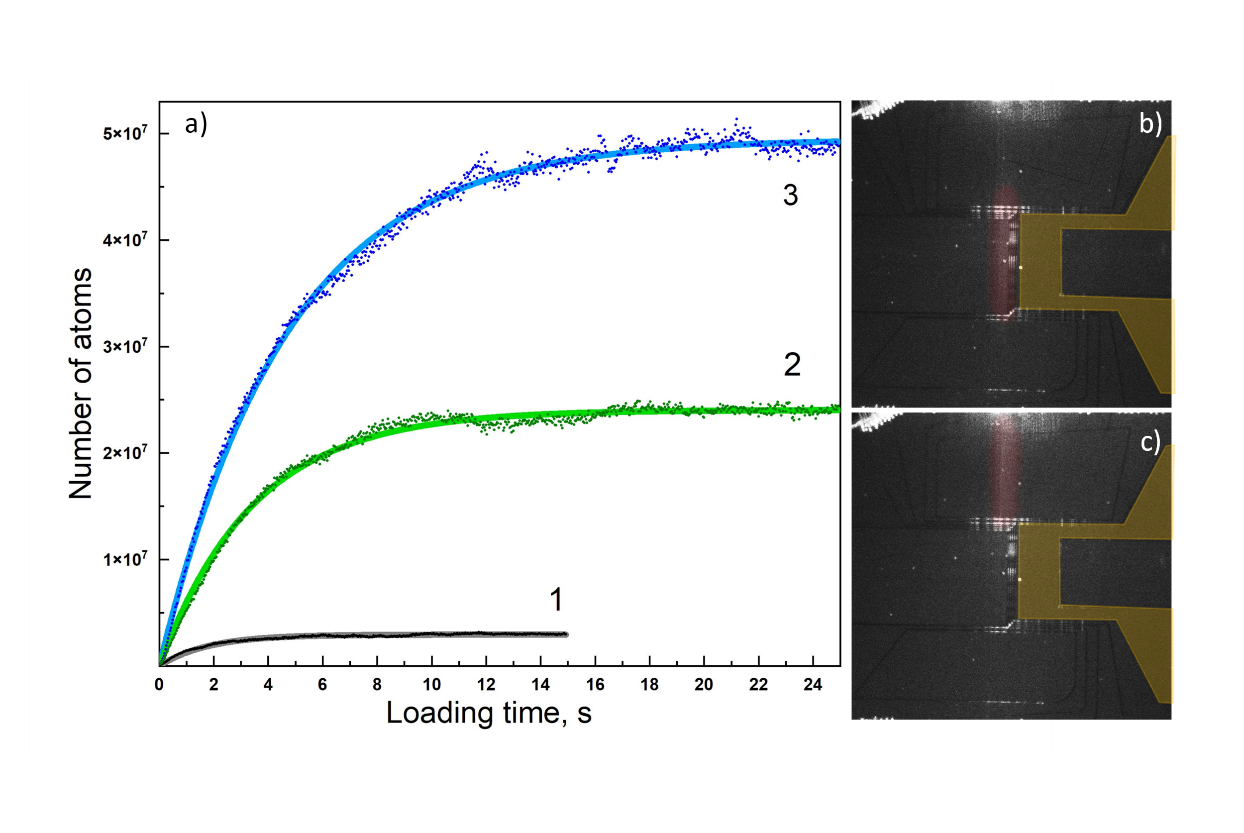
Measured time dependence of the number of atoms in MOT near the atom chip. (a): Black curve (1) corresponds to the loading of atoms from thermal vapor; green curve (2) –loading from a low-velocity atomic beam whose position relative to the center of the atomic chip is shown on the panel (c); blue curve (3) - loading of atoms from a low-velocity atomic beam, whose position is controlled using one-dimensional optical molasses (b). Figures (b) and (c) show photos of the illuminated atomic beam against the background of an atomic chip. The atomic beam propagates from left to the right and is illuminated by a narrow laser beam extending from top to bottom. The areas where of the atomic beam intersects with the laser beam are shown in red. The microwire of the U-shaped trap (through which current flows to form the required magnetic field) is highlighted in yellow.
P.I.Skakunenko et al.,
JETP Letters 119, issue 1 (2024)
The cumulative process is particle production in a kinematical region forbidden for reactions with free nucleons. The SPIN set up provides a detailed study of charged particles emitted with high transverse momentum ( pT > 1 GeV/c) from nuclear targets irradiated with protons from the U70 accelerator of the Institute for High Energy Physics. The working kinematic region of the SPIN experiment makes it possible to study the cumulative particle production caused by hard interactions with dense multiquark (multinucleon) configurations inside nuclear matter. Cross-sections for the antiproton production as a function of momentum are presented in the left figure for four targets, C, Al, Cu and W. The upper horizontal axis shows the X2 values (“Stavinsky variable” [1]), which corresponds to the minimum target mass required to produce antiprotons at an angle of 400. The curves in the left figure are calculations in accordance with the parameterization [2], in which the dependence of the cross sections on the nuclear mass (A) is represented by ~$A^{(2.4+X_2)/3}$. Close to universal for all targets X2-dependence is an evidence for formation of antiprotons in interactions with multinucleon (multiquark) configurations inside a nucleus.
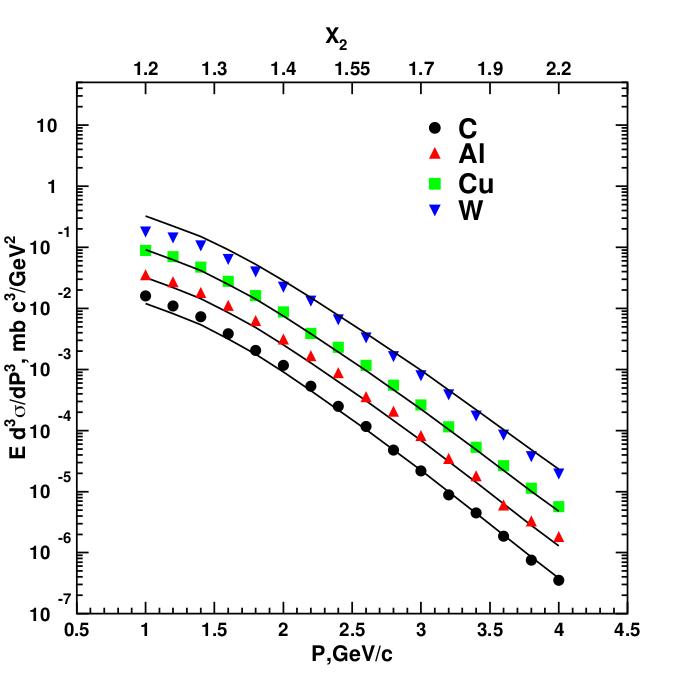
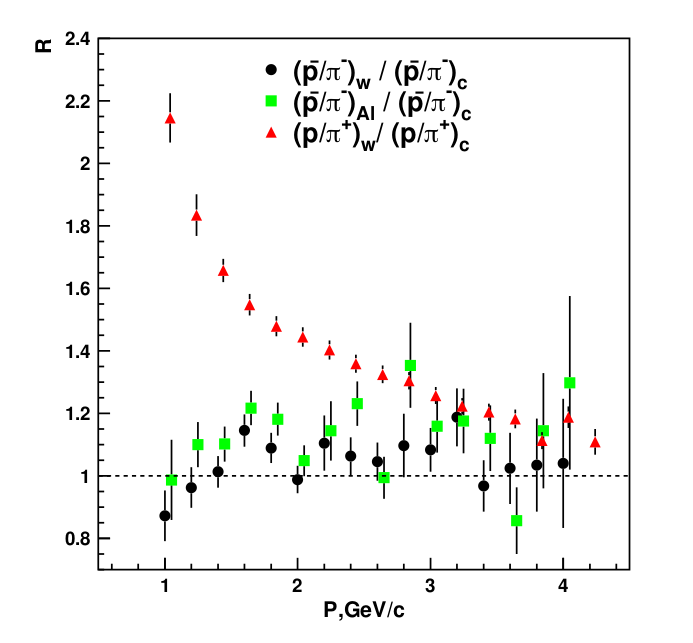
At first glance, the ratio between the yields of antiprotons and $\pi $ mesons looks the same for different nuclei. However, if to devide ($\bf \vec p / \bf \pi^-$) values measured for the heavier nucleus by for carbon target (as it is done in the right figure) one can see that the double ratio does systematically exceed unity, which may indicate certain impact of FSI. The double ratio constructed using the proton and $\pi $spectra from tungsten and carbon samples shows a much stronger influence of secondary processes on the inclusive spectra of proton.
[1] V. S. Stavinskii, JINR Rapid Comm. 18, 5 (1986)
[2] N.N. Antonov et al., Physics of Atomic Nuclei, 2022, Vol. 85, No. 3, pp. 282–288.
N.N. Antonov et al.,
JETP Letters 119, issue 1 (2024)
Profiles of pressure in many tokamaks adhere to the well-established model of canonical profiles proposed by Coppi and developed by Razumova, Dnestrovskii, and others. To predict parameters of future tokamaks, the pressure should be presented as a product of density and temperature. We averaged 162 profiles and observed that the radial profile of electron temperature depends on the radial profile of electron density according to the simple formula Te(ρ) =const ne(ρ)1.65. The analytical model of a density attractor, also known as Turbulent EquiPartition (TEP), assumes that plasma is frozen-in in poloidal magnetic field. The resulting density profile depends on the specific poloidal magnetic volume, ne(ρ)v(ρ)=const. The TEP model and the mechanism of particle pinch were previously confirmed in large aspect ratio tokamaks TCV and JET. Here, we examined the density profiles in a spherical tokamak in hot ion mode and identified the best fit as ne(ρ)v(ρ)1.06=const. The proposed model of neo-canonical profiles predicts electron temperature and density profiles in assumption of a known magnetic configuration. It remains unclear which part of neo-canonical profiles is more rigid - pressure, density, or temperature - or it depends on a tokamak operating regime. The future will reveal whether this model can be extrapolated to ignition parameters or not.
(a) Dependence of local electron density normalized on average density on specific poloidal volume (b) Dependence of local electron temperature on local electron density normalized on average temperature and density. The region of turbulent transport is selected by green.
G.S. Kurskiev, V.V. Yankov, V.K. Gusev, N.S. Zhiltsov, E.O. Kiselev, A.K. Kryzhanovskii, V.B. Minaev, I.V. Miroshnikov, Yu.V. Petrov, N.V. Sakharov,
V.V. Solokha, A.Yu. Telnova, N.V. Teplova, E.E. Tkachenko, G.A. Troshin, E.A. Tyukhmeneva, P.B. Schegolev
JETP Letters 119, issue 1 (2024)
We consider the evolution of an initially planar monolayer of charged microparticles (plasma crystal) equilibrated in both horizontal (in the plane of the monolayer) and vertical parabolic confinements.We use the molecular dynamics simulations to study the buckling-like instability of such a system (using as an example the Yukawa type of interactions between the microparticles) at weakening of the vertical confinement. In particular, it is shown that the radial inhomogeneity of the plasma crystal leads to a qualitatively different character of the layering compared with homogeneous systems: the layering starts in the center of the crystal (where the interparticle distance is less than at periphery) and propagates with weakening of the vertical confinement as a layering wave that moves to the periphery. This effect explains remarkably well the behavior of plasma crystals observed in recent experiments with quasi 2D complex plasmas.
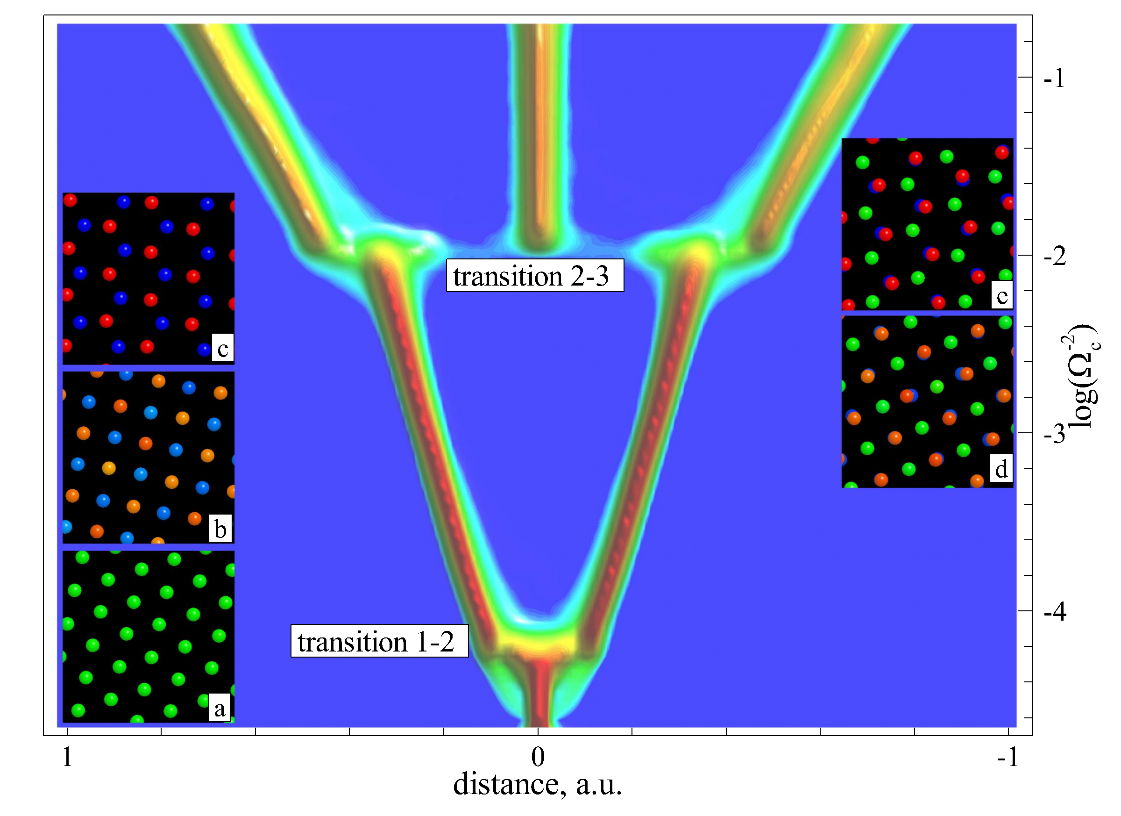
Layering of a planar plasma crystal at weakening of the vertical parabolic confinement. The distribution of particles over the height is shown as a function of on the parameter P characterizing the strength of the confinement. For small values P the system is a monolayer with a hexagonal symmetry (fragment is shown in panel (a)). When the parameter P is increased, the system spontaneously splits into two layers with a shifted square lattice (see, panel (b)). The color of the microparticles is determined by the height: the red particles are located above, and the blue ones are below. A further increase of P leads to a structural transition, i.e. the square lattice is transformed into a hexagonal one for each layer and they are shifted relative to each other (see, panel (c)). The subsequent increase of P leads to the formation of a third layer with the fcc type of symmetry (see, panel(d)), and the lattice transforms into an hcp lattice with hexagonal symmetry of all three layers (the case is shown in panel (e)) then.
B.A. Klumov
JETP Letters 118, issue11 (2023
One possible evidence for CP-violation beyond the Standard Model would be a discovery of non-vanishing Electric Dipole Moments (EDM) of elementary particles. To search for the EDM of charged particles one can store them in a circular accelerator and observe the EDM effect on the beam polarization. The necessary condition for a build-up of the observable EDM-effect is a coherent spin motion. Possible sources of spin decoherence include spin chromaticity, orbit lengthening and spin resonances. In this regard of special interest are novel features of the so-called “frozen spin” storage rings with electrostatic and hybrid E+B bending. The first step to increase the Spin Coherence Time (SCT) is to turn on a radiofrequency cavity. The next step is to manipulate equilibrium energy levels associated with betatron orbit lengthening and nonlinear momentum compaction factor, as suggested by a solution of nonlinear equations of longitudinal motion. We demonstrated that the effective equilibrium energy is a scalar characteristic of the spin motion of a beam with a distribution in a 6D phase space. It has to be the same for all particles in the beam to achieve a high SCT. Spin resonances act as another source of spin-decoherence. Their impact needs to be taken care of especially for the proton beam in the entire energy range of the machine.

Phase trajectory in longitudinal plane for initial coordinates x = 0, y = 0 (a) and x = 3 mm, y = 0 (b); initial dp/p = 1.2 · $10^{−4}$
Melnikov A.A., Senichev Yu.V., Aksentyev A.E., Kolokolchikov S.D.
JETP Letters 118, issue 10 (2023)
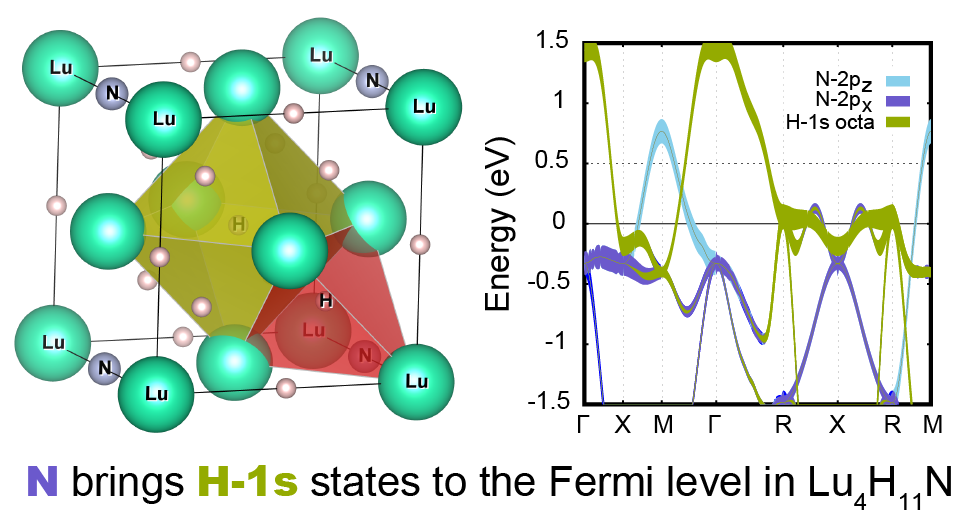
(Left) Crystal structure of LuH2.75N0.25 with two types of H atom surroundings. (Right) The bands projected on Wannier function with linewidth showing contributions of H-1s octahedral and N-2p states
The interest to the charge imbalance phenomena [1,2] has grown recently in connection with planar nanosystem investigations since nonequilibrium quasiparticles appear in mesoscopic superconducting (S) structures due to narrowings, interfaces with submicron normal metal parts (N) etc., even at T<<Tc [3]. We have investigated the quasiparticle transport in planar submicron superconductor/normal metal (S/N) structures with SNS Josephson junctions (Nb-Cu-Nb, Nb-Au-Nb) and normal metal (Cu, Au) N-injectors. A nonlocal supercurrent was observed in Josephson junctions, when nonequilibrium quasiparticles were injected from a normal-metal electrode into one of the superconducting banks of the Josephson junction in the absence of a net transport current through the junction. The occurrence of the nonlocal supercurrent in the junction is related to the need to compensate the quasiparticle flow in it. The charge-imbalance relaxation length in niobium was determined experimentally by using the nonlocal measurement scheme proposed in [3]. Along with aluminum, niobium is the most widely used superconductor for fabrication of superconducting electronic nanodevices, detectors, bolometers.
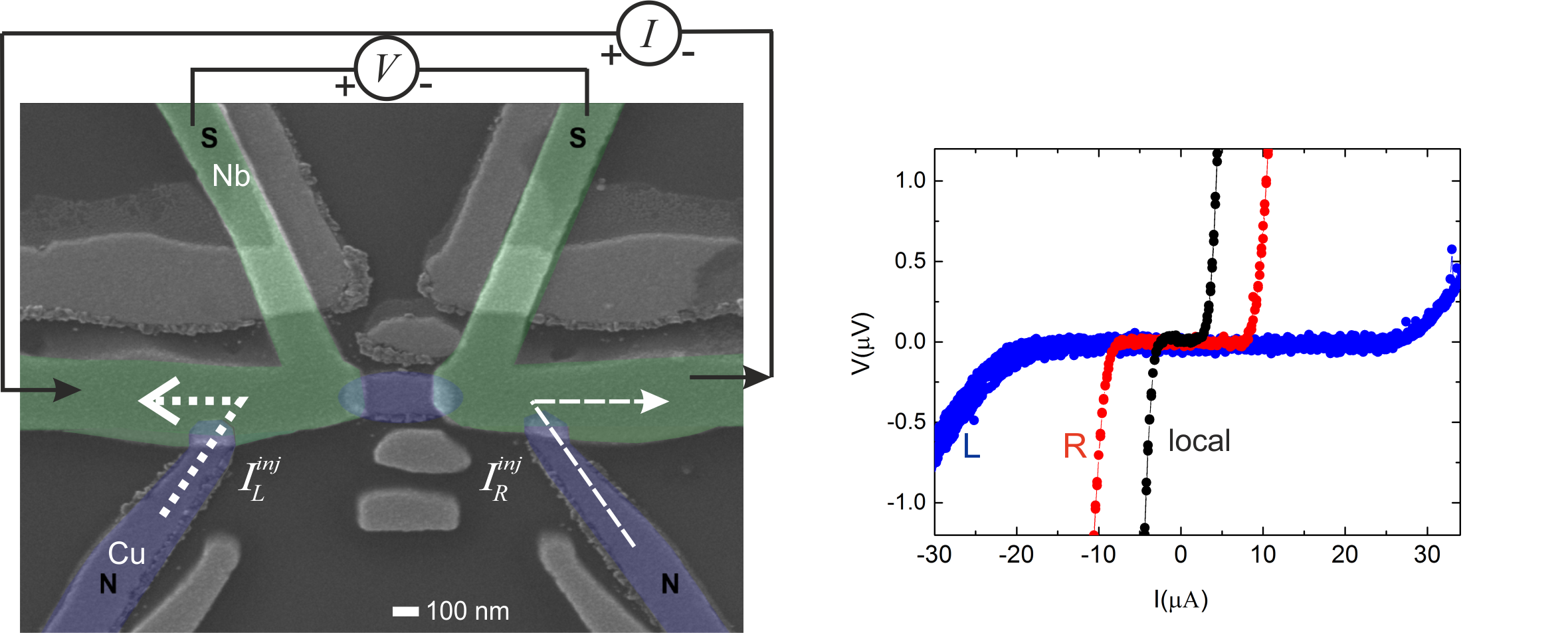
[1] A. Schmid and G. Schön, J. Low Temp. Phys. 20, 207 (1975).
[2] G. J. Dolan and L. D. Jackel, Phys. Rev. Lett. 39, 1628 (1977).
[3] T. E. Golikova, M. J. Wolf, D. Beckmann, I. E. Batov, I. V. Bobkova, A. M. Bobkov, and V. V. Ryazanov, Phys. Rev. B 89 104507 (2014)
I.S. Lakunov, S.V. Egorov, E.D. Mukhanova, I.E. Batov, T.E. Golikova, V.V. Ryazanov
JETP Letters 118, issue 9 (2023)
Cavity polaritons originate from the strong coupling of excitons and light. When excited resonantly, they form macroscopically coherent states. Nonlinear interaction of polaritons involves optical multistability which manifests itself in sharp switches between alternative coherent states in response to varying excitation parameters. As a result, the intensity and polarization of the emitted light can be controlled on a very short (sub-nanosecond) timescale.
Owing to the Zeeman effect in a magnetic field, the polariton system has two branches of optical response that are characterized by opposite circular polarizations. Here, a new mechanism of polarization reversal is predicted, according to which the current state undergoes a transition to dynamical chaos and then the alternative spin state is established spontaneously. Such spin switches, which are mediated by a chaotic stage, proceed in both ways in the vicinity of the same critical point. As a result, the sign of the circular-polarization degree of the emitted light can be directly controlled by the intensity of optical pump.
The figure illustrates the switches between opposite-spin states under the conditions of a slow increase or decrease of the pump intensity as well as the chaotic dynamics of polarization at the intermediate stage; dashed lines are dynamically unstable solutions
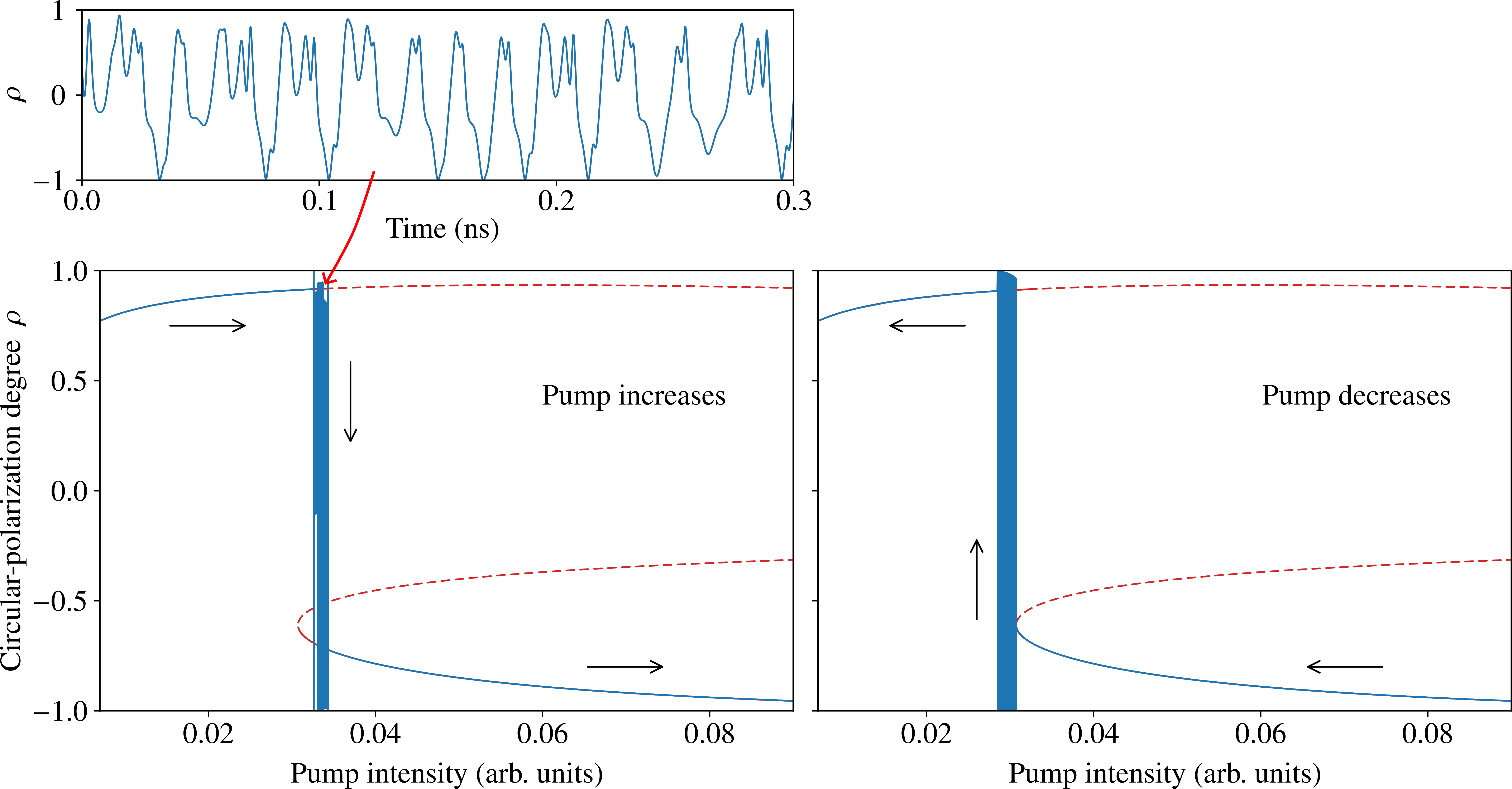
Gavrilov S., Ipatov N., Kulakovskii V.
JETP Letters 118, issue 9 (2023)